SIMPLIFYING RADICAL EXPRESSIONS INVOLVING FRACTIONS
Quotient Property of Radicals
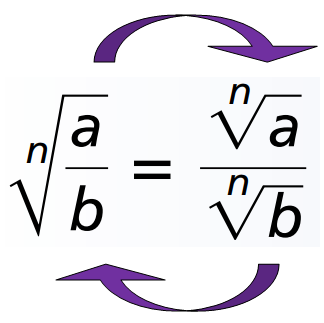
Step 1 :
If you have radical sign for the entire fraction, you have to take radical sign separately for numerator and denominator.
Step 2 :
We have to simplify the radical term according to its power.
- If you have square root (√), you have to take one term out of the square root for every two same terms multiplied inside the radical.
- If you have cube root (3√), you have to take one term out of cube root for every three same terms multiplied inside the radical.
- If you have fourth root (4√), you have to take one term out of fourth root for every four same terms multiplied inside the radical.
Note :
In case, you have prime number inside the radical sign in denominator, you have to multiply both numerator and denominator by the prime number along with the radical sign.
Step 3 :
After taking the terms out from radical sign, we have to simplify the fraction.
Solved Examples
Example 1 :
Use the quotient property to write the following radical expression in simplified form.
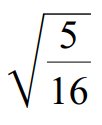
Solution :
√(5/16) = √5 / √16
√(5/16) = √5 / √(4 ⋅ 4)
Index of the given radical is 2.
Because its index is 2, we can take one term out of radical for every two same terms multiplied inside the radical sign.
√(5/16) = √5 / 4
Example 2 :
Use the quotient property to write the following radical expression in simplified form.
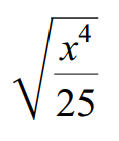
Solution :
√(x4/25) = √x4 / √25
√(x4/25) = √(x2 ⋅ x2) / √(5 ⋅ 5)
Index of the given radical is 2.
Because its index is 2, we can take one term out of radical for every two same terms multiplied inside the radical sign.
√(x4/25) = x2 / 5
Example 3 :
Use the quotient property to write the following radical expression in simplified form.
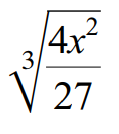
Solution :
3√(4x2/27) = 3√4x2 / 3√27
3√(4x2/27) = 3√(4x2) / 3√(3 ⋅ 3 ⋅ 3)
Index of the given radical is 3.
Because its index is 3, we can one term out of radical for every three same terms multiplied inside the radical sign.
3√(4x2/27) = 3√(4x2) / 3
Example 4 :
Use the quotient property to write the following radical expression in simplified form.
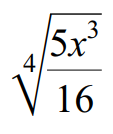
Solution :
4√(5x3/16) = 4√(5x3) / 4√16
4√(5x3/16) = 4√5x3 / 4√(2 ⋅ 2 ⋅ 2 ⋅ 2)
Index of the given radical is 4.
Because its index is 4, we can take one term out of the radical for every four same terms multiplied inside the radical sign.
4√(5x3/16) = 4√5x3 / 2
Example 5 :
Use the quotient property to write the following radical expression in simplified form.
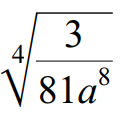
Solution :
4√(3/81a8) = 4√3 / 4√(81a8)
4√(3/81a8) = 4√3 / 4√(3a2 ⋅ 3a2 ⋅ 3a2 ⋅ 3a2)
Index of the given radical is 4.
Because its index is 4, we can take one term out of the radical for every four same terms multiplied inside the radical sign.
4√(3/81a8) = 4√3 / 3a2
Example 6 :
Use the quotient property to write the following radical expression in simplified form.
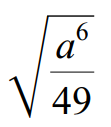
Solution :
√(a6/49) = √a6/√49
√(a6/49) = √(a3 ⋅ a3)/(7 ⋅ 7)
Index of the given radical is 2.
Because its index is 2, we can take one term out of the radical for every two same terms multiplied inside the radical sign.
√(a6/49) = a3/7
Example 7 :
Use the quotient property to write the following radical expression in simplified form.
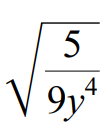
Solution :
√(5/9y4) = √5 / √9y4
√(5/9y4) = √5 / (3y2 ⋅ 3y2)
Index of the given radical is 2.
Because its index is 2, we can take one term out of the radical for every two same terms multiplied inside the radical sign.
√(5/9y4) = √5 / 3y2
Example 8 :
Use the quotient property to write the following radical expression in simplified form.
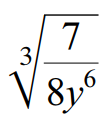
Solution :
3√(7/8y6) = 3√7 / 3√(8y6)
3√(7/8y6) = 3√7 / 3√(2y2 ⋅ 2y2 ⋅ 2y2)
Index of the given radical is 3.
Because its index is 3, we can take one term out of the radical for every three same terms multiplied inside the radical sign.
3√(7/8y6) = 3√7 / 2y2
Kindly mail your feedback to v4formath@gmail.com
We always appreciate your feedback.
©All rights reserved. onlinemath4all.com
Recent Articles
-
Digital SAT Math Problems and Solutions (Part - 150)
Apr 25, 25 11:46 AM
Digital SAT Math Problems and Solutions (Part - 150) -
AP Calculus AB Problems with Solutions (Part - 19)
Apr 24, 25 11:10 PM
AP Calculus AB Problems with Solutions (Part - 19) -
AP Calculus AB Problems with Solutions (Part - 18)
Apr 24, 25 11:06 PM
AP Calculus AB Problems with Solutions (Part - 18)
